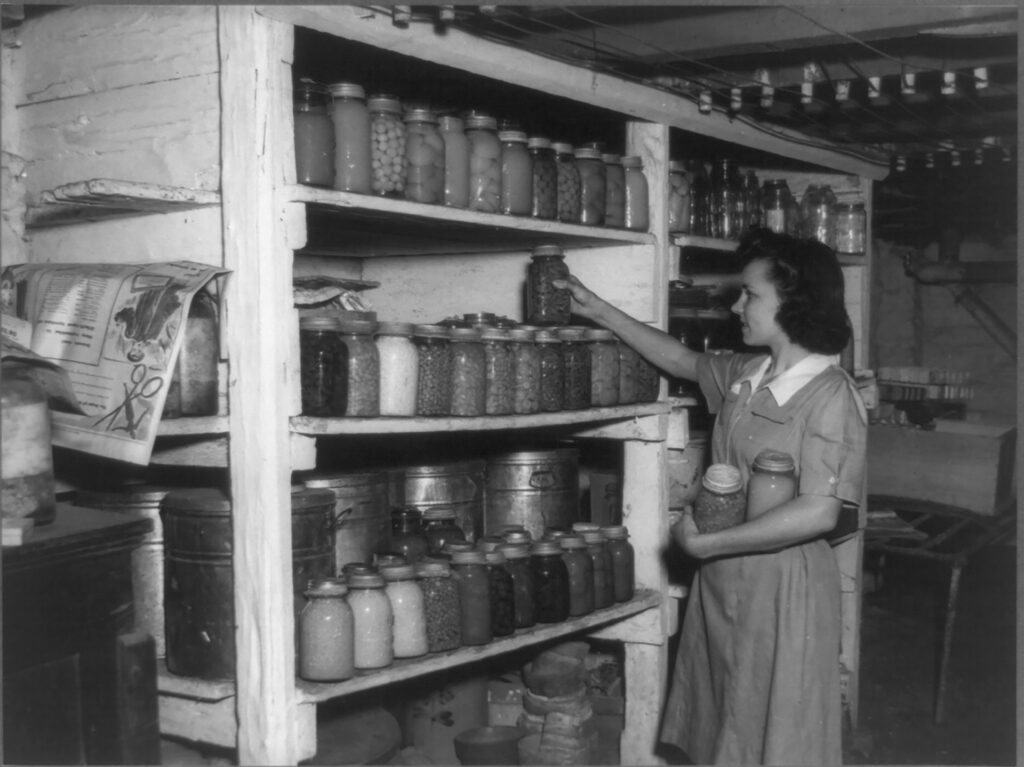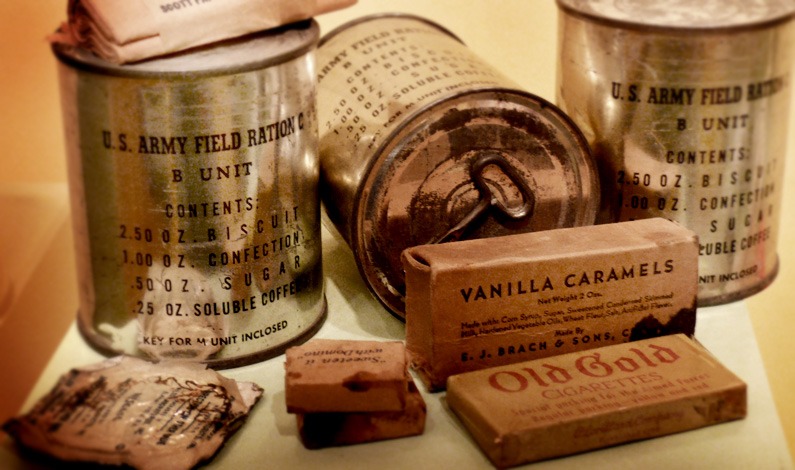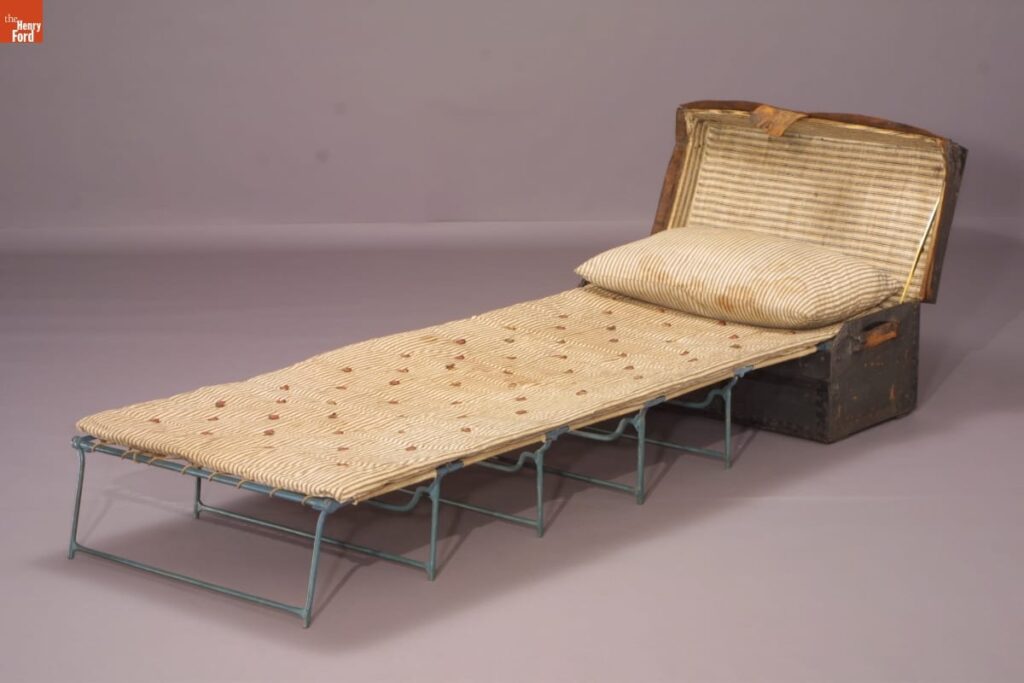Conflict has been an inescapable part of human history. Archaeological evidence points to warfare dating back at least 10,000 years. Understanding history requires acknowledging the succession of conflicts that have molded our civilization.
Most individuals prefer to avoid contemplating, viewing, or reading about warfare. Yet occasionally, we’re compelled to do the opposite—perhaps to gain perspective or understand the reasoning (or lack thereof) behind history-altering struggles.
The following wartime artifacts, none excessively graphic, illuminate compelling narratives and aspects of humanity’s inherent capacity for violence.
1. A Parachute Becomes a Wedding Dress
In August 1944, Major Claude Hensinger and his crew were returning from a bombing mission over Yowata, Japan, when their B-29 engine caught fire. Thanks to his parachute, Hensinger escaped with minimal injuries. He used the parachute as a makeshift bed while waiting for rescue.
When he proposed to his girlfriend Ruth in 1947, Hensinger offered the parachute as material for her wedding dress. Later, their daughter and son’s wife also wore this special garment on their wedding days.
2. Helmet of the First Man at Normandy
Leonard T. Schroeder Jr., a U.S. Army Captain, was the first American to step onto Normandy’s beaches from a landing craft. He led his men down the ramp into waist-deep waters at Utah Beach on D-Day, guiding the 32 soldiers from his Higgins Boat as air support bombed the shore.
Despite landing 2,000 yards off target and getting shot in his left arm, Schroeder bravely led his men to capture the town of Sainte-Marie-du-Mont. He was wounded again in the same arm, but doctors managed to save it. For his bravery, Schroeder received the Silver Star. His M-1 helmet with an ivy cross design is now in a museum.
3. Food Cards During World War I
British citizens faced severe food shortages during World War I. Prices doubled, and basics like meat, bread, and vegetables became hard to find. People’s attitudes changed as frustrations grew. Initial patriotic spirit gave way to hunger and impatience as ration cards could only be used at specific shops.

With the government controlling prices, certain foods became rare, creating long lines outside stores. Items like cheese, milk, sugar, tea, butter, and jam were strictly limited—significantly affecting traditional British meals of sweet tea and jam on crumpets. Some families could only afford one meal per day, while others ate meat just once a week.
4. Bomb Tags Used as a Diary
Technical Sergeant Garland Kerlec worked as a flight engineer on a B-17 bomber. Through many dangerous missions, he remained ready to man the gun turret to protect his crew. His plane was shot up, suffered engine failures, and faced other deadly situations.
Instead of using a regular diary, Kerlec recorded these frightening experiences on the metal pins and bomb tags that kept the explosives from going off too early. While commanders sometimes required soldiers to return all pins, some leaders were more relaxed—as long as the mission was completed.
5. Periscopes for Trench Safety
The horrors of trench warfare led to many inventions, both for attack and defense. This tool served both purposes.
Trenches offered some protection, if you ignore the rats and foot diseases. However, any soldier looking over the edge risked being shot. A periscope made by Adams & Company (from 1917) allowed soldiers to safely view no-man’s land in places like Pays de la Loire, Saint-Nazaire, in France.

Painted dull green for hiding, it had a sliding wood-and-metal cover over the viewfinder. The device folded in half for storage, saving precious space in the wet, dirty, cramped trenches.
6. Bullets That Collided Mid-Air
The Minié ball, despite its name not being round, was an important Civil War invention that changed gun warfare. This cone-shaped bullet had grooves around its bottom, making it more accurate and deadly from farther away. It used rifling—spinning the bullet when fired for better flight.

Created in the late 1840s by French officer Claude-Étienne Minié, this ammunition made the Civil War much deadlier. The two bullets shown became famous not for hitting soldiers but for hitting each other. They collided during “a perfect hurricane of bullets” at “Bloody Hill” on August 10, 1861, during the Battle of Wilson’s Creek, as described by Sergeant George W. Hutt. One bullet was .69 caliber, the other .58 caliber.
7. Canned Military Food
C-Rations evolved from the food packs that fed American troops during World War I. These 12-ounce cans, opened with a key, contained various foods: bacon, beef, biscuits, sugar, coffee, and salt. Some also included items many soldiers valued: tobacco and rolling papers. Later versions added more variety like stews, spaghetti, and candy.


Interestingly, some collectors of these old military items have actually tried tasting the contents of these vintage canned rations.
8. Gas Masks with Hidden Dangers
It’s unusual to hear anyone calling for the destruction of war artifacts, but sometimes these items contain hidden hazards—not evil, but potentially harmful due to toxic materials.
In 2014, the UK’s Health and Safety Executive suggested destroying World War I artifacts containing asbestos, including helmets, gas masks, and other items shown to the public or shared with children for education.
Of 34 helmets examined, both German and British, 29 contained asbestos in their filters. Six had the especially dangerous “blue asbestos” (crocidolite). Historians and sensible people were understandably upset by suggestions to destroy irreplaceable historical items. Since this was only discovered in the 2000s, the health impact on original users remains unknown.
9. Flame Throwers as Fear Weapons
The flame thrower, or flammenwerfer, was invented by German engineer Richard Fiedler around 1900. German troops first used it during World War I as a siege weapon around 1915, successfully using it against French trenches near Verdun.
The weapon was later changed from a frontal attack tool to one for clearing trenches or fortified spots. Its usefulness as an attack weapon was limited by its short range (about 20 yards) and small fuel capacity. However, it made up for practical limitations with psychological impact, becoming perhaps the most terrifying weapon in popular imagination.
10. Bitten Bullets Myth and Reality
Civil War medicine was clearly less advanced than modern methods, but wasn’t as primitive or limited as many believe.
Contrary to popular stories, surgery patients didn’t bite bullets during operations. While early surgery was indeed brutal and far from clean, doctors had options, including chloroform and ether to help patients. Curiously, war artifacts do include many bullets with teeth marks—not from wounded soldiers during surgery, but from pigs that scavenged battlefields after fighting stopped.
BONUS: George Washington’s Traveling Bed

We often picture generals giving orders from safe positions far from their troops. Yet George Washington stayed close to his Revolutionary War soldiers, carrying personal items like eating utensils while sharing their camps. Among the most interesting items is his uncomfortable camp bed, likely used around July 1783 during his inspection of military bases in upstate New York as the American Revolution was ending.